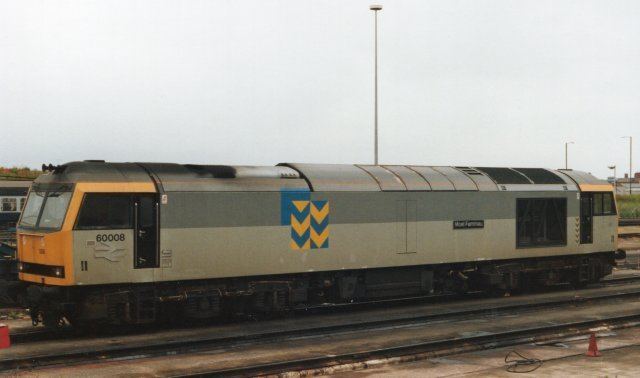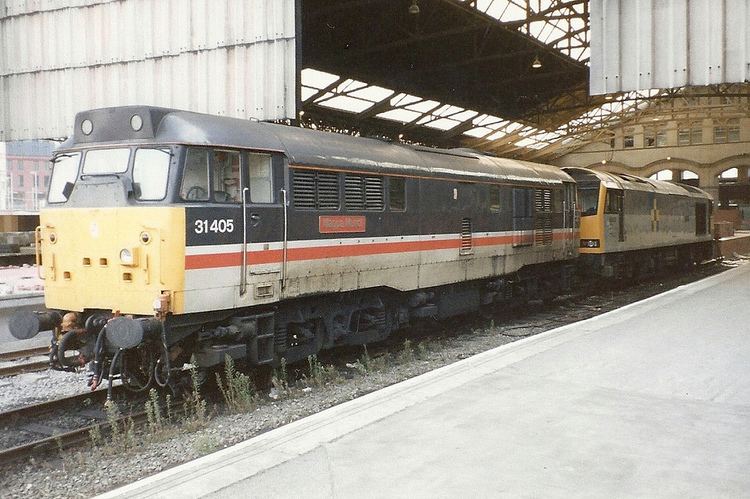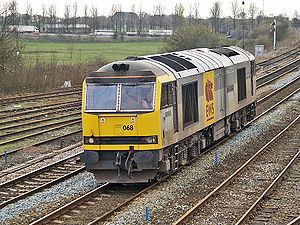Power type Diesel-electric Build date 1989–1993 Configuration Co-Co | Total produced 100 AAR wheel arr. C-C | |
 | ||
6 class 60 the power to move mountains
The British Rail Class 60 is a class of Co-Co heavy freight diesel-electric locomotives built by Brush Traction. They are nicknamed Tugs by rail enthusiasts.
Contents
- 6 class 60 the power to move mountains
- Hornby r3266 class 60 diesel locomotive 60090 br coal sector quinag oo gauge review hd
- History
- Bodywork
- Electrical
- Prime mover
- British Rail
- English Welsh and Scottish Railway
- DB Schenker
- Colas Rail
- Accidents and incidents
- Naming and liveries
- Preservation
- Models
- References

Hornby r3266 class 60 diesel locomotive 60090 br coal sector quinag oo gauge review hd
History

In the 1980s, British Rail decided it had a requirement for a high powered Type 5 diesel locomotive for use on its Trainload Freight sector. On 10 August 1987, the British Railways Board issued a competitive tender for response by 7 November, for a fleet of 100 locomotives. Of the six companies invited to tender, only three bid responses were received:


Of the three bidders, Brush was selected, and an order was placed for 100 locomotives in a deal worth around £120 million.

Brush sub-contracted parts construction, with final construction at Brush's erecting shops at Loughborough. The bodyshells, shared with the Class 92 electric locomotives, were fabricated by Procor (UK) of Wakefield. The engine was a higher-powered development of the Mirrlees engine previously fitted experimentally to British Rail Class 37 nos. 37901-37904.
The first locomotive was delivered in June 1989 and sent to Derby for testing, which revealed a number of teething problems. Parts requiring modifications included the axle box suspension and the Mirlees engine cylinder head.
Bodywork
Unlike the Classes 59 and 66 (solid girder underframe) the Class 60s have a monocoque stressed skin construction with diagonal trusses - with the external bodywork providing support for the internal components.
Two different cab designs were considered and full size mock-ups were made in wood, plastic and metal by the Engineering Development Unit at the Railway Technical Centre in Derby. One of these had a French-style raked-forward cab end, similar to the SNCF Class CC 72000, but this was rejected in favour of a more conventional cab.
Electrical
The main alternator is a Brush BA1006A type, providing power for the traction motors via rectification circuits to DC, the auxiliary alternator is Brush BAA 702A Auxiliary Alternator, providing power for the radiator fans, lubrication and fuel oil pumps, traction motor cooling fans and air compressors amongst others. The main and auxiliary alternators are both driven by the main engine.
Each of the six axles are driven via a reduction gear by one nose suspended axle hung traction motor (Brush designed and built TM2161A four pole motors). Each motor has a separate microprocessor-controlled power supply (SEPEX in Brush's designation - from "Separately Excited"), a system that was first tried on the Class 58. One feature of this system is that if one set of wheels/axle/motor starts to wheelslip their speed can be reduced without affecting the other motors.
Prime mover
The engine is an 8-cylinder, 145 litre Mirrlees Blackstone 8MB275T diesel traction engine (275 mm cylinder diameter); the Mirrlees engine was one of the most fuel efficient available at the time (189g of fuel per kWhr), but relatively heavy. The engine was also successfully installed in marine applications such as small ships and passenger ferries. The low cylinder count for the rated power was expected to result in lower maintenance costs.
British Rail
By 1990, the class had started to be introduced onto the mainline, replacing previously double headed Class 33 Type 3s in the South East region, as well as Classes 20, 26, 27, 31 and 73. The class 60s primarily worked on aggregate (specifically stone) traffic also replacing Class 56s and Class 58s, some of which were withdrawn, others transferred. Their introduction replaced double-heading and also allowed longer and/or heavier trains to be worked.
English, Welsh and Scottish Railway
Following the privatisation of British Rail all 100 units came under the management of the English Welsh & Scottish (EWS), It was EWS's policy not to reduce the 100 strong fleet, with both fire and collision damaged locomotives receiving repairs. In 2003/04 a number of the fleet were stored, surplus to requirements. Between 2004 and 2007 typically between 50–75% of the fleet would be out of action at a given time. In 2007 the operational fleet was estimated to be 60 locomotives.
DB Schenker
In June 2007 EWS was acquired by DB Schenker, a wholly owned subsidiary of the German railway company, Deutsche Bahn. Since working for EWS/DB Schenker, Class 60s have typically been employed on stone, aggregate, ballast and petroleum traffic and also on steel trains. By 2009 many Class 60s were in storage, with only fifteen in operation at any one time.
In September 2010 twenty of the class were offered for disposal by DB Schenker UK, whilst in November 2010 DBS annonuced that 20 units would be overhauled. In January 2011 DB Schenker announced that seven units would undergo an overhaul, with an option of an overhaul on a further fourteen units. In January 2013, the overhaul was described as an "upgrade" to create a new fleet of "Super 60's". DB Schenker gave no technical details but, according to Tugtracker, there were mechanical upgrades trialled on 60099 and electrical upgrades trialled on 60011. Tugtracker also gives a list of eighteen locomotives upgraded between 1 September 2011 and 1 October 2013.
In 2012 some Class 60s were offered for sale through Romic-Ace International Pte Ltd. In late 2013 DB Schenker Rail UK offered 20 units for sale. These were to be purchased on 31 October 2013 by Doncaster-based Wabtec Rail in a £10m deal - the deal was reported to have fallen through in 2014. In August 2016 DB Schenker puts 20 class 60s up for sale. These are 60003, 004, 005, 006, 008, 013, 014, 018, 022, 023, 025, 027, 030, 031, 032, 037, 042, 050, 051, 052.
Colas Rail
In June 2014 it was reported that 10 locos have been sold to Colas Rail. The numbers are 60 002/021/026/047/056/076/085/087/095/096. The first one to appear in the Colas yellow and orange livery was 60087, which was photographed at Burton-on-Trent on 2 June 2014.
Accidents and incidents
Naming and liveries
In 1989 Railfreight named the Class 60s in traditional fashion; those locomotives attached to the construction and metals sectors were named after British mountains as were some attached to the coal sector. The others (coal and petroleum sectors) received the names of famous British citizens, with an emphasis on those whose contribution had been to science and engineering. Locomotives numbered 60001 and 60098 were exceptions, being named "Steadfast" and "Charles Francis Brush" respectively. The locomotives received the standard liveries of their respective sectors.
After coming into EWS's ownership, the Class 60 locomotives were repainted in the red and yellow EWS livery as and when repainting was necessary. Many others carried vinyl stickers on their sides over the former BR sector liveries, demonstrating EWS's ownership. A few locos received names including 60033: Corus "Tees Steel Express" and 60081: repainted in a mock Great Western Railway green livery and renamed Isambard Kingdom Brunel in 2000.
In 2007/08, two locomotives received special liveries: 60074 received a 'powder blue' livery and was named "Teenage Spirit" at the NRM in York as part of a charity event for the "Teenage Cancer Trust". 60040 was repainted in a red livery and named "The Territorial Army Centenary" as part of the celebration of that event. Both of these locos have since been repainted into standard DB Schenker livery.
In 2010 class 60 number 60099 was repainted into a Tata Steel silver livery and logo at Toton TMD and unveiled at Tata's Scunthorpe plant on 27 September.
In January 2011, 60011 became the first member of the class to receive the standard DB Schenker livery, after a repaint at Toton TMD.
In late May 2014, 60087 emerged from Toton TMD in Colas livery. It has now been joined by 60002, 021, 026, 047, 056, 076, 085, 095 and 096.
Preservation
The Class 60 Preservation Group aims to secure a Class 60 for preservation, when one becomes available.
Models
The locomotives have been reproduced in scale model form by Heljan in O scale, Lima and Hornby in OO scale and Graham Farish in British N scale.
